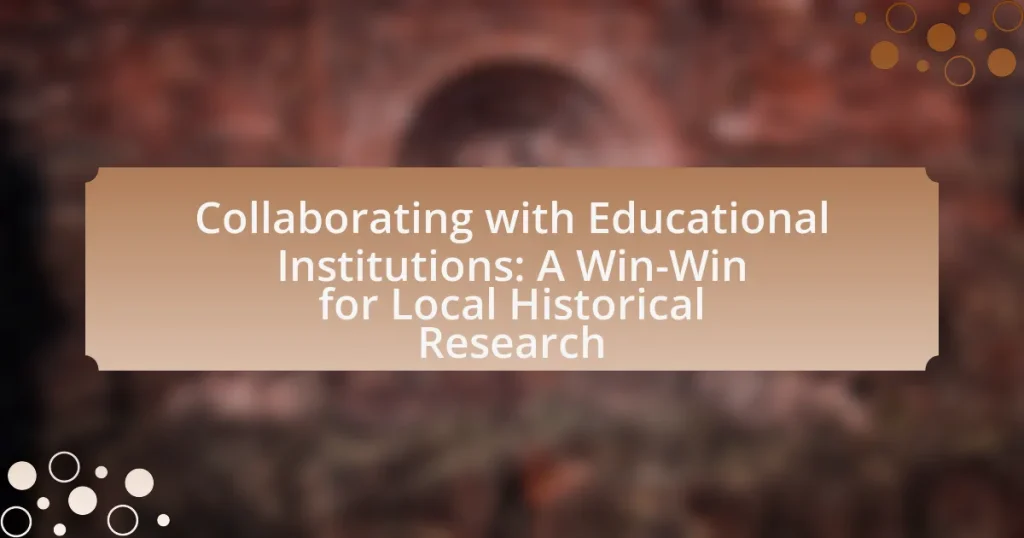Collaborating with educational institutions plays a crucial role in enhancing local historical research by fostering partnerships between schools, colleges, and communities. This collaboration leverages academic resources and expertise, resulting in comprehensive historical narratives and increased community engagement. Key elements of effective collaboration include clear communication, mutual respect, and shared goals, which facilitate successful projects such as community history initiatives and archival research. Educational institutions provide unique resources, including access to specialized libraries and expert faculty, while also offering students practical experience in historical inquiry. Overall, these partnerships not only enrich the research process but also promote the preservation of local heritage.
What is Collaborating with Educational Institutions for Local Historical Research?
Collaborating with educational institutions for local historical research involves partnerships between schools, colleges, or universities and local communities to explore, document, and preserve historical narratives and artifacts. This collaboration enhances research quality by leveraging academic resources, expertise, and methodologies, while also providing students with practical experience in historical inquiry. For instance, projects may include student-led oral history interviews or archival research, which contribute to a richer understanding of local history. Such partnerships have been shown to increase community engagement and awareness of historical issues, as evidenced by initiatives like the “Community History Project” at the University of California, which successfully documented the histories of underrepresented communities.
How does collaboration enhance local historical research?
Collaboration enhances local historical research by pooling resources, expertise, and diverse perspectives from various stakeholders, including educational institutions, local historians, and community members. This collective effort leads to more comprehensive and accurate historical narratives, as seen in projects like the “Local History Project” conducted by the University of California, which involved students and local historians working together to document regional history. Such collaborations not only enrich the research process but also foster community engagement and ownership of local history, ultimately resulting in a more robust understanding of the past.
What are the key elements of effective collaboration?
The key elements of effective collaboration include clear communication, mutual respect, shared goals, and trust among participants. Clear communication ensures that all parties understand their roles and responsibilities, which is essential for coordination. Mutual respect fosters a positive environment where diverse perspectives are valued, enhancing creativity and problem-solving. Shared goals align the efforts of all collaborators, providing a common purpose that drives the project forward. Trust builds a foundation for open dialogue and risk-taking, which are crucial for innovation and overcoming challenges. These elements are supported by research indicating that successful collaborations often exhibit these characteristics, leading to more productive and impactful outcomes.
How do educational institutions contribute to historical research?
Educational institutions contribute to historical research by providing access to resources, expertise, and collaborative opportunities. Universities and colleges often house extensive libraries, archives, and databases that are essential for historical inquiry. For instance, the Library of Congress and various university libraries maintain vast collections of primary sources, including manuscripts, photographs, and government documents that are crucial for researchers. Additionally, faculty members in history departments offer specialized knowledge and mentorship, guiding students and researchers in their investigations. Collaborative projects between educational institutions and local historical societies can also lead to the preservation of local history, as seen in initiatives like the National History Day program, which encourages students to engage in historical research and presentation. These contributions enhance the depth and breadth of historical understanding and scholarship.
Why is collaboration important for local historical research?
Collaboration is important for local historical research because it enhances the depth and breadth of knowledge through shared resources and expertise. When researchers work together with educational institutions, they gain access to a wider array of archival materials, scholarly databases, and expert guidance, which can lead to more comprehensive and accurate historical narratives. For instance, partnerships with universities often provide researchers with access to specialized training and methodologies, as well as opportunities for interdisciplinary approaches that can enrich local history studies. This collaborative effort not only fosters a more thorough understanding of local history but also encourages community engagement and preservation of cultural heritage.
What unique resources do educational institutions provide?
Educational institutions provide unique resources such as access to specialized libraries, archives, and expert faculty. These resources facilitate in-depth research and offer a wealth of historical documents, manuscripts, and academic publications that are often not available to the general public. For example, many universities house extensive collections of local history materials, including rare books and primary source documents, which are invaluable for historical research. Additionally, faculty members often possess expertise in specific historical fields, providing guidance and mentorship to researchers.
How does collaboration benefit students and researchers alike?
Collaboration benefits students and researchers by enhancing knowledge sharing and resource access. Students gain practical experience and mentorship from researchers, while researchers benefit from fresh perspectives and innovative ideas brought by students. This synergy fosters a dynamic learning environment, leading to improved research outcomes and academic performance. Studies show that collaborative projects often result in higher-quality research outputs, as evidenced by a 2018 report from the National Science Foundation, which highlighted that interdisciplinary collaboration increased publication rates by 20%.
What are the different forms of collaboration with educational institutions?
Different forms of collaboration with educational institutions include partnerships for research projects, internships, guest lectures, curriculum development, and community outreach programs. These collaborations enable educational institutions to leverage external expertise and resources while providing practical experiences for students. For instance, research partnerships often involve joint studies that benefit both the institution and the collaborating entity, enhancing academic knowledge and practical applications. Internships allow students to gain hands-on experience in their field of study, fostering professional development. Guest lectures bring industry professionals into the classroom, enriching the learning experience with real-world insights. Curriculum development collaborations ensure that educational programs remain relevant and aligned with industry needs. Community outreach programs engage students in local initiatives, promoting civic responsibility and enhancing community ties.
How can local historians partner with universities?
Local historians can partner with universities by engaging in collaborative research projects that leverage academic resources and expertise. This partnership allows local historians to access university facilities, funding, and scholarly networks, while universities benefit from the rich, localized knowledge that historians possess. For instance, joint initiatives can include community history projects, oral history collections, and public history exhibitions, which enhance both academic scholarship and community engagement. Such collaborations have been shown to foster a deeper understanding of local heritage and promote educational outreach, as evidenced by successful programs at institutions like the University of California, which has partnered with local historians to document regional histories.
What types of projects can be developed through these partnerships?
Partnerships with educational institutions can develop projects such as community history initiatives, archival research projects, and educational programs focused on local heritage. These projects often involve students and faculty collaborating with local historians and organizations to document, preserve, and promote local history. For instance, a community history initiative may include oral history projects that gather personal narratives from residents, while archival research projects could focus on digitizing historical documents for public access. Educational programs might involve workshops or lectures that engage the community in understanding their historical context, thereby fostering a deeper appreciation for local heritage.
How can internships and volunteer programs enhance collaboration?
Internships and volunteer programs enhance collaboration by fostering partnerships between educational institutions and local organizations. These programs create opportunities for students to engage in hands-on experiences, allowing them to contribute to projects that require teamwork and shared goals. For instance, a study by the National Association of Colleges and Employers found that 70% of employers value candidates with internship experience, indicating that such programs not only benefit students but also strengthen ties between academia and the community. This collaborative environment encourages knowledge exchange, resource sharing, and the development of skills that are essential for successful teamwork in historical research initiatives.
What role do community colleges play in local historical research?
Community colleges play a significant role in local historical research by providing accessible educational resources and fostering community engagement. They often serve as hubs for historical inquiry, offering courses and programs that encourage students and local residents to explore regional history. For instance, many community colleges collaborate with local historical societies and museums, facilitating research projects that document and preserve local heritage. This collaboration not only enhances the educational experience for students but also contributes valuable insights and data to the broader historical narrative of the community.
How can community colleges support local historical initiatives?
Community colleges can support local historical initiatives by providing resources such as research facilities, expert faculty, and student volunteers. These institutions often have access to archives, libraries, and technology that can aid in the preservation and study of local history. For example, community colleges can partner with local historical societies to offer courses or workshops focused on regional history, thereby enhancing community engagement and awareness. Additionally, students can participate in internships or service-learning projects that contribute to historical research, documentation, and preservation efforts, fostering a deeper connection between the college and the community.
What programs can be implemented to foster collaboration?
Programs that can be implemented to foster collaboration include joint research initiatives, internship programs, and community engagement projects. Joint research initiatives allow educational institutions and local historical organizations to work together on specific historical topics, leveraging academic resources and local expertise. Internship programs provide students with hands-on experience in historical research while benefiting local organizations with fresh perspectives and manpower. Community engagement projects encourage collaboration through events, workshops, and public history initiatives, promoting shared knowledge and resources between institutions and the community. These programs have been shown to enhance educational outcomes and strengthen community ties, as evidenced by successful partnerships documented in various case studies.
What challenges might arise in collaborating with educational institutions?
Collaborating with educational institutions may present challenges such as differing priorities and bureaucratic hurdles. Educational institutions often prioritize academic standards and institutional policies, which can conflict with the goals of external collaborators. Additionally, navigating the complex administrative processes required for partnership agreements can lead to delays and misunderstandings. These challenges are supported by research indicating that successful collaborations often require alignment of objectives and clear communication to mitigate potential conflicts.
How can communication barriers affect collaboration?
Communication barriers can significantly hinder collaboration by creating misunderstandings and reducing the effectiveness of information exchange. When individuals or groups cannot effectively share ideas, goals, or feedback, it leads to confusion, misalignment of objectives, and decreased productivity. For instance, research indicates that 70% of workplace errors stem from poor communication, which directly impacts team dynamics and project outcomes. In the context of collaborating with educational institutions for local historical research, these barriers can prevent the sharing of valuable insights and resources, ultimately limiting the success of joint initiatives.
What strategies can be employed to improve communication?
To improve communication, strategies such as active listening, clear messaging, and regular feedback can be employed. Active listening ensures that all parties feel heard and understood, which fosters a collaborative environment. Clear messaging involves articulating thoughts and ideas in a straightforward manner, reducing the chances of misinterpretation. Regular feedback allows for continuous improvement in communication practices, ensuring that misunderstandings are addressed promptly. Research indicates that organizations that implement these strategies experience enhanced teamwork and productivity, as effective communication is linked to better collaboration outcomes.
How can differing goals between institutions and local historians be reconciled?
Differing goals between institutions and local historians can be reconciled through collaborative projects that align institutional resources with local historical narratives. By establishing partnerships, institutions can provide funding, research support, and access to archives, while local historians contribute unique insights and contextual knowledge about their communities. For example, initiatives like community-based history projects have successfully integrated institutional frameworks with local expertise, resulting in enriched historical documentation and preservation efforts. This synergy not only enhances the quality of historical research but also fosters a sense of ownership and relevance among local communities, ensuring that both parties achieve their objectives.
What logistical issues should be considered in collaboration?
Logistical issues in collaboration with educational institutions include communication barriers, resource allocation, scheduling conflicts, and data management. Effective communication is essential to ensure all parties are aligned on goals and expectations, as misunderstandings can hinder progress. Resource allocation involves determining how materials, funding, and personnel will be shared, which can impact the project’s success. Scheduling conflicts arise when participants have differing availability, making it crucial to establish a timeline that accommodates all stakeholders. Lastly, data management is vital for organizing and sharing research findings, requiring clear protocols to maintain data integrity and accessibility.
How can funding and resource allocation be managed effectively?
Funding and resource allocation can be managed effectively by implementing a structured budgeting process that aligns financial resources with strategic goals. This involves conducting a thorough needs assessment to identify priorities, followed by the development of a detailed budget that allocates funds based on these identified needs. Research indicates that organizations that utilize performance metrics to evaluate the impact of funding decisions tend to achieve better outcomes; for instance, a study by the National Bureau of Economic Research found that targeted funding in educational settings significantly improved student performance. Additionally, regular monitoring and evaluation of resource utilization ensure that funds are being used efficiently and can be reallocated as necessary to maximize impact.
What are the best practices for project management in collaborative efforts?
The best practices for project management in collaborative efforts include establishing clear communication channels, defining roles and responsibilities, and setting measurable goals. Clear communication ensures that all team members are aligned and informed, which is critical for successful collaboration. Defining roles and responsibilities helps to avoid confusion and overlap, allowing each participant to contribute effectively. Setting measurable goals provides a framework for tracking progress and evaluating success, which is essential in collaborative projects. These practices are supported by research indicating that effective communication and defined roles significantly enhance project outcomes in collaborative environments.
What are the best practices for successful collaboration?
The best practices for successful collaboration include establishing clear communication, defining roles and responsibilities, and setting shared goals. Clear communication ensures that all parties understand expectations and can address issues promptly, which is crucial in collaborative efforts. Defining roles and responsibilities helps to avoid confusion and overlap, allowing each participant to contribute effectively based on their expertise. Setting shared goals aligns the efforts of all collaborators towards a common purpose, enhancing motivation and accountability. Research indicates that organizations that prioritize these practices experience higher levels of satisfaction and productivity in collaborative projects.
How can clear objectives be established for collaborative projects?
Clear objectives for collaborative projects can be established by engaging all stakeholders in a structured planning process. This involves defining specific, measurable, achievable, relevant, and time-bound (SMART) goals that align with the interests and capabilities of each participant. Research indicates that involving diverse perspectives enhances clarity and commitment, as seen in studies on collaborative learning environments, which show that shared goal-setting leads to improved outcomes in educational settings.
What methods can be used to evaluate the success of collaborations?
To evaluate the success of collaborations, methods such as qualitative assessments, quantitative metrics, and stakeholder feedback can be employed. Qualitative assessments involve analyzing the depth of engagement and the quality of interactions among collaborators, often through interviews or focus groups. Quantitative metrics can include measuring specific outcomes like the number of joint publications, funding secured, or community impact indicators. Stakeholder feedback, gathered through surveys or discussions, provides insights into the perceived value and effectiveness of the collaboration from various perspectives. These methods collectively offer a comprehensive view of collaboration success, supported by evidence from studies indicating that effective evaluation leads to improved future partnerships.















